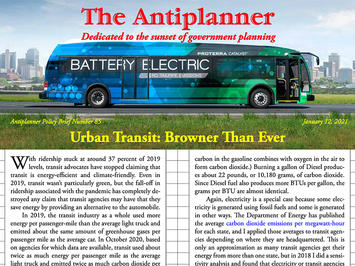
Democrats want to build more transit infrastructure in order to reduce greenhouse gas emissions. The only problem is that transit emits as much or more greenhouse gases, per passenger mile, as the average car. In fact, transit is less climate friendly than driving in all but a handful of cities.
Now, a new report from the Transit Cooperative Research Program of the National Academy of Sciences attempts to quantify how much greenhouse gas emissions transit can save. Using data from the American Public Transportation Association, the report observes that each passenger mile carried by transit represents a reduction of just 0.329 vehicle miles of automobile travel (page 14). Apparently, about 60 percent of those transit trips would, in the absence of transit, otherwise be walking or cycling trips or would not take place at all.
That means that transit is a huge net generator of greenhouse gases. In 2018, the average car emitted 202 grams of carbon dioxide per passenger mile. In 2019, transit did better than that only in the New York, Philadelphia, San Francisco, and Portland urban areas. The average light truck emitted about 241 grams; transit did better than that only in the above urban areas plus Atlanta, Boston, and San Jose.
But the numbers are even worse for transit if it only takes a third of vehicle miles off the road per passenger-mile. In 2018, the average car emitted 311 grams per vehicle-mile and the average light truck 438. Multiplying those numbers by 32.9 percent means each transit passenger mile saves 102 grams by car or 144 grams by light truck. About 55 percent of light vehicles are light trucks, so the weighted average is 125 grams. Only in New York and San Francisco do transit systems do better than that. Elsewhere, the best thing we can do to reduce greenhouse gas emissions is to shut down transit.
Except that the National Academy report then goes on to claim that transit “can lead to location efficiency — where destinations like employment and shopping are closer to the households that need them.” Or, more specifically, “transit investments, service improvements, and associated development” can lead to such efficiency. Based on this claim, the paper somehow calculated that each passenger-mile on transit saves an average of 1.6 vehicle-miles of driving (page 16).
This is quite a stretch. Many new transit lines have resulted in no land-use changes. To get any land-use changes, cities such as Portland and Seattle have had to subsidize the construction of so-called transit-oriented developments. Even after their construction, researchers have found that the developments do not significantly change people’s transportation habits. Instead, the developments attract people who aren’t driving that much anyway; people who drive a lot either don’t live in such developments or continue to drive after moving in.
As UC Irvine economist David Brownstone observes in a paper based on research he did for the National Academy of Sciences, most studies that claim that land-use changes will change travel habits (including the studies cited in the previous paper) fail to take self-selection into account. Once that is considered, Brownstone concluded, the effects of changes in density on driving are “too small” to be useful “for trying to reduce VMT or greenhouse gas emissions from residential vehicles.”
Census data show that in 1980, before Portland built its first light-rail line, 10 percent of Portland-area commuters took transit to work. Portland now has five light-rail lines, a commuter-rail line, and two streetcar lines, yet just 8 percent of Portland-area commuters took transit to work in 2019.
Read the rest of this piece at The Antiplanner.
Click here to download a four-page PDF of this policy brief.
Randal O'Toole (rot@ti.org) is a senior fellow with the Cato Institute analyzing land-use and transportation policies and the author of American Nightmare: How Government Undermines the Dream of Homeownership.
Photo credit: screenshot of report cover, by the author.












